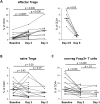Regulatory T Cell Responses to High-Dose Methylprednisolone in Active Systemic Lupus Erythematosus
- PMID: 26629828
- PMCID: PMC4667921
- DOI: 10.1371/journal.pone.0143689
Regulatory T Cell Responses to High-Dose Methylprednisolone in Active Systemic Lupus Erythematosus
Abstract
Background/purpose: A slight increase in the proportion of circulating regulatory T (Treg) cells has been reported in systemic lupus erythematosus (SLE) patients taking oral prednisone. The effects of intravenous (IV) high dose methylprednisolone (MP) on Tregs have not yet been described, especially in active SLE.
Methods: We prospectively analyzed the proportion of circulating CD4+ Treg cell subsets defined as follows: (1) naïve Treg (nTreg) FoxP3lowCD45RA+ cells; (2) effector Treg (eTreg) FoxP3highCD45RA- cells; and (3) non-suppressive FoxP3lowCD45RA- cells (non-regulatory Foxp3low T cells). Peripheral blood mononuclear cells of patients with active SLE were analyzed before the first infusion of IV high dose MP (day 0) and the following days (day 1, day 2, ±day 3 and ±day 8). The activity of SLE was assessed by the SLEDAI score.
Results: Seventeen patients were included. Following MP infusions, the median (range) percentage of eTregs significantly increased from 1.62% (0.53-8.43) at day 0 to 2.80% (0.83-14.60) at day 1 (p = 0.003 versus day 0), 4.64% (0.50-12.40) at day 2 (p = 0.06 versus day 1) and 7.50% (1.02-20.70) at day 3 (p = 0.008 versus day 2), and declined to baseline values at day 8. Expanding eTreg cells were actively proliferating, as they expressed Ki-67. The frequency of non-regulatory FoxP3low T cells decreased from 6.39% (3.20-17.70) at day 0 to 4.74% (1.03-9.72) at day 2 (p = 0.005); nTreg frequency did not change. All patients clinically improved immediately after MP pulses. The absence of flare after one year of follow up was associated with a higher frequency of eTregs at day 2.
Conclusion: IV high dose MP induces a rapid, dramatic and transient increase in circulating regulatory T cells. This increase may participate in the preventive effect of MP on subsequent flares in SLE.
Conflict of interest statement
Figures



References
Publication types
MeSH terms
Substances
LinkOut - more resources
Full Text Sources
Other Literature Sources
Medical
Research Materials

